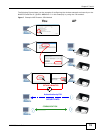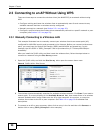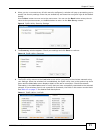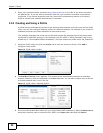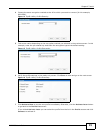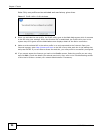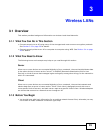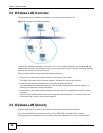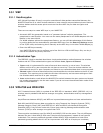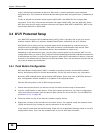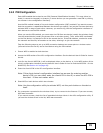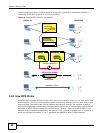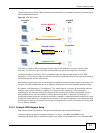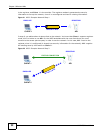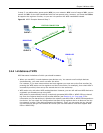
Chapter 3 Wireless LANs
NWD2705 User’s Guide
27
3.3.1 WEP
3.3.1.1 Data Encryption
WEP (Wired Equivalent Privacy) encryption scrambles all data packets transmitted between the
NWD2705 and the AP or other wireless stations to keep network communications private. Both the
wireless stations and the access points must use the same WEP key for data encryption and
decryption.
There are two ways to create WEP keys in your NWD2705.
• Automatic WEP key generation based on a “password phrase” called a passphrase. The
passphrase is case sensitive. You must use the same passphrase for all WLAN adapters with this
feature in the same WLAN.
For WLAN adapters without the passphrase feature, you can still take advantage of this feature
by writing down the four automatically generated WEP keys from the Security Settings screen
of the ZyXEL utility and entering them manually as the WEP keys in the other WLAN adapter(s).
• Enter the WEP keys manually.
Your NWD2705 allows you to configure up to four 64-bit or 128-bit WEP keys. Only one key is
used as the default key at any one time.
3.3.1.2 Authentication Type
The IEEE 802.11b/g/n standard describes a simple authentication method between the wireless
stations and AP. Three authentication types are defined: Auto, Open and Shared.
• Open mode is implemented for ease-of-use and when security is not an issue. The wireless
station and the AP or peer computer do not share a secret key. Thus the wireless stations can
associate with any AP or peer computer and listen to any transmitted data that is not encrypted.
• Shared mode involves a shared secret key to authenticate the wireless station to the AP or peer
computer. This requires you to enable the wireless LAN security and use same settings on both
the wireless station and the AP or peer computer.
• Auto authentication mode allows the NWD2705 to switch between the open system and shared
key modes automatically. Use the auto mode if you do not know the authentication mode of the
other wireless stations.
3.3.2 WPA-PSK and WPA2-PSK
Wi-Fi Protected Access (WPA) is a subset of the IEEE 802.11i standard. WPA2 (IEEE 802.11i) is a
wireless security standard that defines stronger encryption, authentication and key management
than WPA.
Key differences between WPA(2) and WEP are improved data encryption and user authentication.
Both WPA and WPA2 improve data encryption by using Temporal Key Integrity Protocol (TKIP),
Message Integrity Check (MIC) and IEEE 802.1x. WPA and WPA2 use Advanced Encryption
Standard (AES) in the Counter mode with Cipher block chaining Message authentication code
Protocol (CCMP) to offer stronger encryption than TKIP.
The encryption mechanisms used for WPA(2) and WPA(2)-PSK are the same. The only difference
between the two is that WPA(2)-PSK uses a simple common password, instead of user-specific
credentials. The common-password approach makes WPA(2)-PSK susceptible to brute-force
password-guessing attacks but it’s still an improvement over WEP as it employs a consistent,



